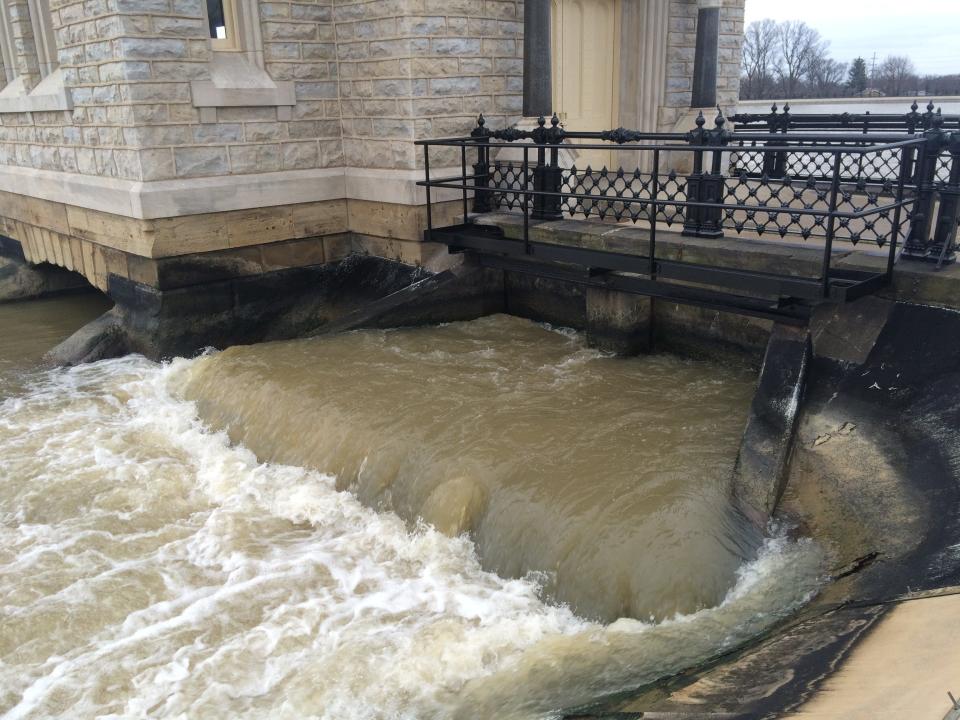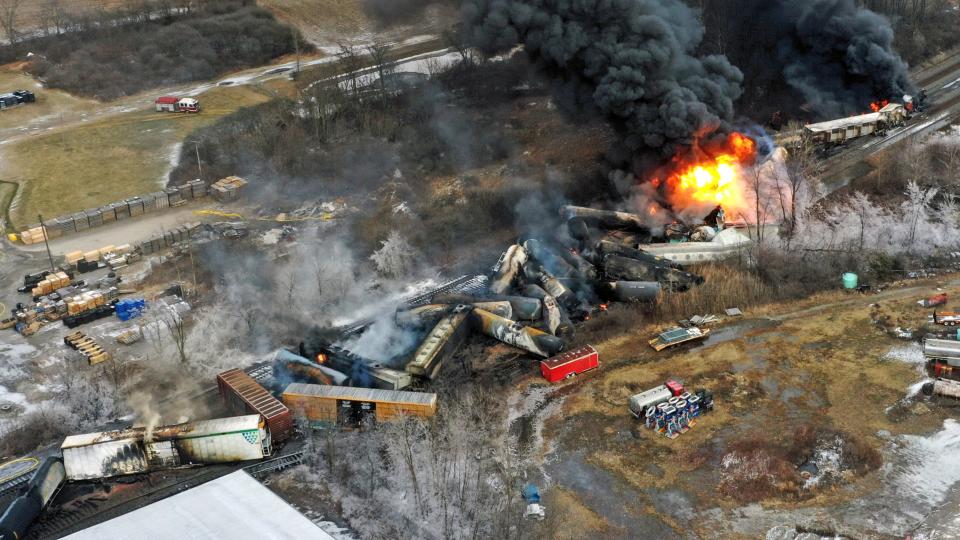Ohio train wreck chemical spill nearing Kentucky border. What we know
Chemicals that spilled into the Ohio River following a disastrous train derailment in East Palestine, Ohio, are forecasted to reach Kentucky in the next day or so, according to estimates from water officials in the region.
Ashland, Kentucky, and nearby communities would be the first in the state to confront the chemical spill as it makes its way downstream, but the plume could be diluted beyond detection by the time it arrives.
Following the Feb. 3 wreck, involving 53 cars of a Norfolk Southern freight train, significant amounts of vinyl chloride and other contaminants billowed into the air or spilled into local waterways, and many downstream communities began to fear contamination in their drinking water.
Since then, multiple water utilities — including Louisville Water Co. — said this week the spill does not pose a risk to drinking water and public health. The chemicals are degrading as they move downstream, and anything left in source water for cities like Cincinnati and Louisville can be removed by existing filtration systems, such as conventional chlorine or activated carbon, officials have said.
Background:Pollution from Ohio train wreck headed toward Louisville. What water company officials say
Some utilities across the region have opted to temporarily switch intakes instead, when another water source is available.
The Ohio River Valley Water Sanitation Commission, which has helped lead regional efforts to understand the extent of water contamination, has been tracking the spill as it travels hundreds of miles downstream.
ORSANCO shared its preliminary sampling data with The Courier Journal, but the data has not gone through the commission's routine quality checks yet. The commission is working to vet the numbers and provide them to the public as soon as possible, according to Richard Harrison, ORSANCO’s executive director and chief engineer.
“It’s not prudent to give out approximate information,” he said.
However, those preliminary numbers agree with official statements claiming that levels of butyl acrylate are hundreds of times lower than federal thresholds from the Agency for Toxic Substances and Disease Registry.
Water utilities up and down the Ohio have used this upstream sampling data to make their individual public health decisions. And despite the low concentrations, monitoring will continue.
“We want the value to always be zero," Harrison said. "That’s why we’re working so hard on this.”
More:Lawyers to East Palestine residents: 'Do not' sign settlements without consultation
Where does Louisville get its water?

Louisville residents are among more than 5 million people who rely on the Ohio River for drinking water every day.
Most of Louisville's drinking water comes from the Crescent Hill Water Treatment Plant, which pumps directly from the Ohio, in addition to the B.E. Payne plant, which uses riverbank filtration. Both are operated by the Louisville Water Co.
But detections of the contaminants involved in the East Palestine train derailment are currently still far upstream, and traveling slowly.
Tracking the Ohio River chemical spill
The main contaminant of concern in water, according to regional officials, is butyl acrylate, which is not classified as a carcinogen. ORSANCO monitoring suggests the spill is approaching Huntington, West Virginia, as of Thursday morning.
The plume is traveling along the river at about 1 mile per hour, Harrison said, meaning it will take days to reach Cincinnati and longer to reach Louisville. Thursday's forecasted rainfall could accelerate the flow, but will also help dilute chemical concentrations.
Butyl acrylate is insoluble and tends to float on the surface of the river, and the river’s length and slow flow provide time for the chemical to degrade, according to Louisville Water Co.
On Thursday, Harrison said he wouldn't be surprised if the spill was diluted beyond detection by the time it reached Kentucky's portion of the river. Similarly, Chris Bobay, water quality manager for the water company, doesn’t expect to see the chemicals in Louisville.
“Our best friend is the river itself,” Bobay said at a Monday news conference. “It’s a pretty thriving ecosystem, and handles its own problems.”
Utilities respond downstream

Ahead of the spill’s arrival, West Virginia American Water temporarily switched water supplies for Huntington, West Virginia, from the Ohio River to the Guyandotte River, as a “precautionary measure,” according to the utility.
Small and mid-sized water systems are also preparing based on updates from ORSANCO. Ashland, Kentucky, is a town of more than 20,000, just downstream from Huntington. Its water system operates the first Kentucky intake from the Ohio River.
The system's operators plan to draw from a nearby reservoir while the spill passes by, Mark Hall, Ashland’s director of utilities, said Wednesday. The spill was expected to reach Ashland by Friday, according to ORSANCO, but that was before the rain accelerated flow and dilution.
Further downstream, water utilities in Cincinnati and Louisville aren’t expecting any trouble in treating the chemicals, when and if they make it there. Bobay said scientists at the Louisville Water Co. are researching the best ways to remove the contaminants, and are confident that existing treatments will be sufficient.
The Indiana Department of Environmental Management issued a statement saying that if chemicals reach the state, utilities “may close their intakes to allow the majority of the chemical to pass,” and that “precautionary treatment strategies may also be used.”
More:Trains are becoming less safe. Why the Ohio derailment disaster could happen more often
Meanwhile, the community in East Palestine is working to recover from the disaster. The EPA continues to test the air and water for contaminants, and has screened hundreds of homes for chemicals.
Norfolk Southern is creating a $1 million fund as part of its recovery in East Palestine, the company announced Tuesday, and has been distributing bottled water, though the town’s municipal water was declared safe to drink as of Wednesday afternoon.
This story is a collaboration between the Mississippi River Basin Ag & Water Desk and The Courier Journal.
The Mississippi River Basin Ag & Water Desk is an editorially independent reporting network based at the University of Missouri School of Journalism.
This article originally appeared on Louisville Courier Journal: East Palestine Ohio train wreck chemical spill nearing Kentucky

